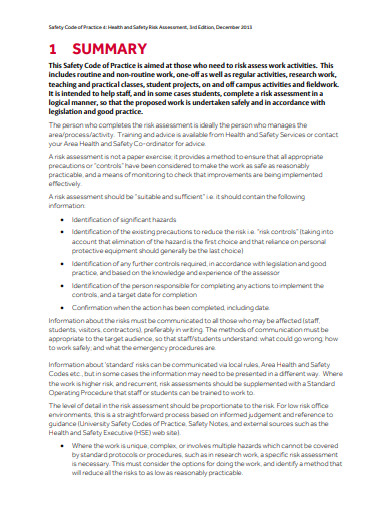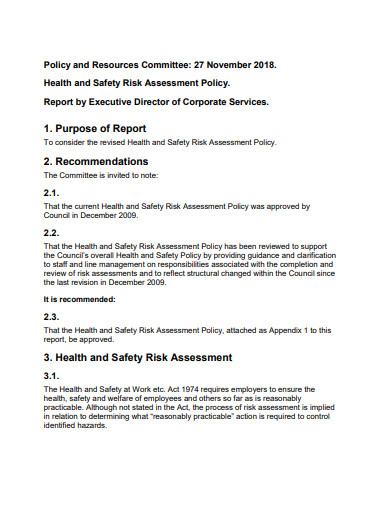11+ Safety Risk Assessment Examples to Download
Every day, no matter where you are or what you’re doing, there is a chance that you are exposed to risks and hazards. If you’re not careful enough, even an innocent banana peel could cause you to end up in a hospital. Your workplace is not an exception to that. According to an estimation by the International Labour Organization, 340 million occupational accidents take place each year. A lot of things could go wrong in your workplace, and these incidents could sometimes lead to death. To avoid these hazards, you need to perform a thorough safety risk assessment.
What Is a Safety Risk Assessment?
A safety risk assessment is a crucial process to ensure the safety of the workplace and to protect the health of your employees. During the process of this job risk assessment, your workplace will be examined to identify possible hazards, assess the likelihood of injuries, and implement safety measures to reduce the risks in the workplace. As an employer, the health and well-being of your employees is your responsibility. So you should prioritize your employees’ health, above all else.
11+ Safety Risk Assessment Examples
1. Safety Risk Assessment Example
2. Electrical Safety Risk Assessment
3. Health and Safety Risk Assessment Format
4. Sample Health and Safety Risk Assessment
5. Health and Safety Risk Assessment Procedure
6. Basic Health and Safety Risk Assessment
7. Health and Safety Risk Assessment
8. Health and Safety Risk Assessment Policy
9. Event Safety Generic Risk Assessment
10. Health and Safety Risk Assessment Policy Format
11. Event Safety Risk Assessment and Management Plan
12. Fire Safety Risk Assessment Format
How to Control Hazards and Risks in the Workplace
In controlling the hazards in your workplace, you need to make sure that everything is checked and secured. Your employees’ lives are what’s at stake; hence you should do it discreetly. One wrong move could endanger not only your employee but also your company. Follow these steps to keep your workplace safe from risks and hazards.
1. Execute a Safety Risk Assessment
There are several steps in executing a safety risk assessment in your workplace. The first one is hazard identification. Inspect every corner of your workplace and look for anything that could cause harm to anyone. It could be places that are trip hazards, wirings, harmful substances, equipment, or even machines. Second, you need to decide who’s most likely to be harmed. After that, evaluate the hazard and develop functional safety measures to reduce them. The fourth step is to record your findings and implement your safety policies. As your company utilizes new machinery and substances, it is important to note that you should always review and update your assessment. Assessing the risks in your work environment is not a job for just anyone—you should ask experts for help.
2. Promote Awareness
Ignorance is dangerous. That is why you must educate your employees on what to do when their life is put at risk, so they will know how to manage and respond to dangerous situations. The best way to educate them is to organize regular training sessions, drills, and seminars regarding safety procedures. These seminars might appear like a hassle, but the things that you would learn from this would really come in handy in the future.
3. Cultivate a Healthy Working Environment
The hazards and risks in your workplace aren’t only limited to accidents. Workplace violence also poses a great threat to your employees. A lot of things can fuel an individual’s violence. It could be a misunderstanding, influence of alcohol and other drugs, being mentally unstable, and being isolated. According to Injury Facts, workplace violence resulted in 453 deaths and 20,790 injuries. To prevent these instances, you should cultivate a welcoming working environment where employees can voice out their concerns and suggestions. Make sure to maintain communication that flows both ways in your office. However, this task might be overwhelming during chaotic situations. In these moments, it is advisable to get help and appoint leaders in every team. These leaders could further pay attention to their team members and offer them the guidance that they need in their job.
4. Ask Experts for Help
At times when accidents inevitably happen, it is better to ask help from the experts. You can contact a lawyer or a police officer depending on the situation. These experts can offer you guidance and share their knowledge regarding the situation. They can also suggest what policies you should remove or improve to keep your company safer.
What are the five types of safety risk assessment?
The five types of risk assessment are as follows: qualitative risk assessment, quantitative risk assessment, generic risk assessment, site-specific risk assessment, and dynamic risk assessment. The qualitative risk assessment is the most common type of assessment. The basis of this is the subjective judgment of the specialist. When an assessor uses a numerical value in assessing the risk, then that is a quantitative risk assessment. You use this type of risk assessment in evaluating nuclear plants and aircraft design. A generic risk assessment is a general assessment of activity. This type covers the common hazards of the activity in a single assessment, which helps to avoid duplication in paperwork. A site-specific risk assessment takes into account the specific location of the work. Lastly, a dynamic risk assessment happens when the risk assessment occurs on the spot. When handling uncertain situations, they use this type of risk assessment often.
What is the difference between risk and hazard?
It is a common misconception that these words are synonymous. However, these two terms mean differently from each other. A hazard is any source that can cause harm or inflict pain. Some examples are stress from work, electricity, harmful substances, and pointy objects. A risk is the probability of a person or employee getting harmed by the hazard.
What do you mean by PPE?
The PPE or personal protective equipment is the equipment that you should wear to avoid too much exposure to hazards that can result in serious injuries and illnesses. These equipment include boots, safety glasses, gloves, vests, hard hats, earmuffs, and others. It is important to wear these if your work is dangerous or if it is in a dangerous place.
Reduce the overwhelming number of workplace accidents with a regular safety risk assessment in your building. Doing this would benefit not only your employees but also your company. If you offer your employees a safe and healthy working environment, then they would most likely grow and improve more. Bear in mind that when their performance improves, the company improves with it. Your workplace should be a place where the life of your employees will begin, not end.














